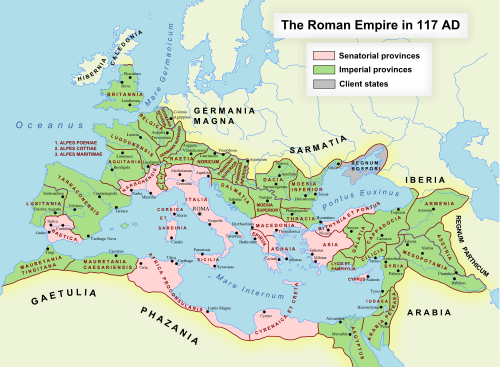Ancient history of Cyprus
The ancient history of Cyprus shows a precocious sophistication in the neolithic era visible in settlements such as at Choirokoitia dating from the 9th millennium BC, and at Kalavassos from about 7500 BC.
Part of a series on the |
|---|
| History of Cyprus |
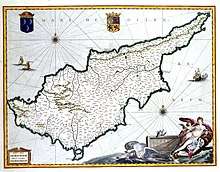 |
|
|
Periods of Cyprus's ancient history from 1050 BC have been named according to styles of pottery as follows:
- Cypro-Geometric I: 1050–950 BC
- Cypro-Geometric II: 950–850 BC
- Cypro-Geometric III: 850–700 BC
- Cypro-Archaic I: 700–600 BC
- Cypro-Archaic II: 600–475 BC
- Cypro-Classical I: 475–400 BC
- Cypro-Classical II: 400–323 BC
The documented history of Cyprus begins in the 8th century BC. The town of Kition, now Larnaka, recorded part of the ancient history of Cyprus on a stele that commemorated a victory by Sargon II (722–705 BC) of Assyria there in 709 BC.[1][2] Assyrian domination of Cyprus (known as Iatnanna by the Assyrians) appears to have begun earlier than this, during the reign of Tiglath-Pileser III (744–727 BC),[3] and ended with the fall of the Neo Assyrian Empire in 609 BC, whereupon the city-kingdoms of Cyprus gained independence once more. Following a brief period of Egyptian domination in the sixth century BC, Cyprus fell under Persian rule. The Persians did not interfere in the internal affairs of Cyprus, leaving the city-kingdoms to continue striking their own coins and waging war amongst one another, until the late-fourth century BC saw the overthrow of the Persian Empire by Alexander the Great.
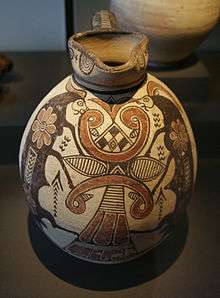
Alexander's conquests only served to accelerate an already clear drift towards Hellenisation in Cyprus.[4] His premature death in 323 BC led to a period of turmoil as Ptolemy I Soter and Demetrius I of Macedon fought together for supremacy in that region, but by 294 BC, the Ptolemaic kingdom had regained control and Cyprus remained under Ptolemaic rule until 58 BC, when it became a Roman province. During this period, Phoenician and native Cypriot traits disappeared, together with the old Cypriot syllabic script, and Cyprus became thoroughly Hellenised. Cyprus figures prominently in the early history of Christianity, being the first province of Rome to be ruled by a Christian governor, in the first century, and providing a backdrop for events in the New Testament[5]
Early history
Mycenaean settlement
The Ancient Greek historian Herodotus (5th century BC) claims that the city of Kourion, near present-day Limassol, was founded by Achaean settlers from Argos. He supports the discovery of a Late Bronze Age settlement lying several kilometres from the site of the remains of the Hellenic city of Kourion, whose pottery and architecture indicate that Mycenaean settlers did indeed arrive and augment an existing population in this part of Cyprus in the twelfth century BC.[6] The kingdom of Kourion in Cyprus is recorded on an inscription dating to the period of the Pharaoh Ramses III (1186–1155 BC) in Egypt.[6]
Assyrian conquest
An early written source of Cypriot history mentions the nation under Assyrian rule as stele found in 1845 in the city formerly named Kition, near present-day Larnaka, commemorates the victory of King Sargon II (721–05 BC) in 709 BC over seven kings in the land of Ia', in the district of Iadnana or Atnana.[7] The land of Ia' is assumed to be the Assyrian name for Cyprus, and some scholars suggest that the latter may mean 'the islands of the Danaans', or Greece. There are other inscriptions referring to the land of Ia' in Sargon's palace at Khorsabad.[8]
The ten kingdoms listed on the prism[1] of Esarhaddon in 673–2 BC have been identified as Soloi, Salamis, Paphos, Kourion, Amathus and Kition on the coast, and Tamassos, Ledrai, Idalion and Chytroi in the interior of the island. Later inscriptions add Marion, Lapithos and Kerynia (Kyrenia).[9]
Independent city-kingdoms
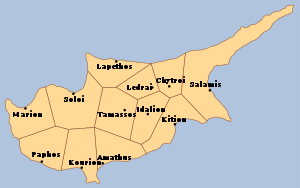
Cyprus gained independence after 627 BC following the death of Ashurbanipal, the last great Assyrian king. Cemeteries from this period are chiefly rock-cut tombs. They have been found, among other locations, at Tamassos, Soloi, Patriki and Trachonas. The rock-cut 'Royal' tombs at Tamassos, built in about 600 BC, imitate wooden houses. The pillars show Phoenician influence. Some graves contain the remains of horses and chariots.
The main deity of ancient Cyprus was the Great Goddess, the Assyro-Babylonian Ishtar, and Phoenician Astarte, later known by the Greek name Aphrodite.[10] She was called "the Cypriote" by Homer. Paphian inscriptions call her "the Queen". Pictures of Aphrodite appear on the coins of Salamis as well, demonstrating that her cult had a larger regional influence. In addition, the King of Paphos was the High Priest of Aphrodite. Other Gods venerated include the Phoenician Anat, Baal, Eshmun, Reshef, Mikal and Melkart and the Egyptian Hathor, Thoth, Bes and Ptah, as attested by amulets. Animal sacrifices are attested to on terracotta-votives. The Sanctuary of Ayia Irini contained over 2,000 figurines.
Egyptian period
In 570 BCE, Cyprus was conquered by Egypt under Amasis II. This brief period of Egyptian domination left its influence mainly in the arts, especially sculpture, where the rigidity and the dress of the Egyptian style can be observed. Cypriot artists later discarded this Egyptian style in favour of Greek prototypes.
Statues in stone often show a mixture of Egyptian and Greek influence. In particular, ceramics recovered on Cyprus show influence from ancient Crete. Men often wore Egyptian wigs and Assyrian-style beards. Armour and dress showed western Asiatic elements as well.
Persian period
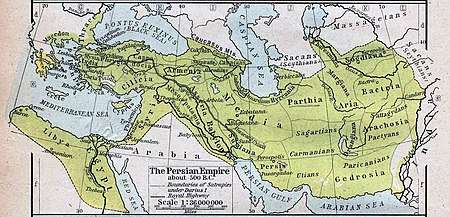
In 525 BCE, the Persian Achaemenid Empire conquered Cyprus. Under the Persians, the Kings of Cyprus retained their independence but had to pay tribute to their overlord. The city-kingdoms began to strike their own coins in the late-sixth century BCE, using the Persian weight system. Coins minted by the kings were required to have the overlord's portrait on them. King Evelthon of Salamis (560–25 BCE) was probably the first to cast silver or bronze coins in Cyprus; the coins were designed with a ram on the obverse and an ankh (Egyptian symbol of good luck) on the reverse.
Royal palaces have been excavated in Palaepaphos and in Vouni in the territory of Marion on the North coast. They closely follow Persian examples like Persepolis. Vouni, on a hill overlooking Morphou Bay, was built around 520 BCE and destroyed in 380 BCE. It contained Royal audience chambers (liwan), open courtyards, bathhouses and stores.
Towns in Cyprus during this period were fortified with mudbrick walls on stone foundations and rectangular bastions. The houses were constructed of mud-bricks as well, whereas public buildings were faced with ashlar. The Phoenician town of Carpasia, near Rizokarpasso (Turkish: Dipkarpaz), had houses built of rubble masonry with square stone blocks forming the corners. Temples and sanctuaries were built mainly in a Phoenician style. Soloi had a small temple with a Greek plan.
A definite influence from Greece was responsible for the production of some very important sculptures. The archaic Greek art with its attractive smile on the face of the statue is found on many Cypriot pieces dating between 525–475 BCE; that is, the closing years of the Archaic period in Greece. During the Persian rule, Ionian influence on the sculptures intensified; copies of Greek korai appear, as well as statues of men in Greek dress. Naked kouroi, however, although common in Greece, are extremely rare in Cyprus, while women (Korai) are always presented dressed with rich folds in their garments. The pottery in Cyprus retained its local influences, although some Greek pottery was imported.
The most important obligation of the kings of Cyprus to the Shah of Persia was the payment of tribute and the supply of armies and ships for his foreign campaigns. Thus, when Xerxes in 480 BC invaded Greece, Cyprus contributed 150 ships to the Persian military expedition.
Ionian revolt
Except for the royal city of Amathus, the Kingdoms of Cyprus took part in the Ionian Revolt in 499 BC. The revolt on Cyprus was led by Onesilos of Salamis, brother of the King of Salamis, whom he dethroned for not wanting to fight for independence. The Persians crushed the Cypriot armies and laid siege to the fortified towns in 498 BCE.[11] Soloi surrendered after a five-month siege.
Around 450 BCE, Kition annexed Idalion with Persian help. The importance of Kition increased again when it acquired the Tamassos copper-mines.
Evagoras I of Salamis
Evagoras I of Salamis (435–374 BCE) dominated Cypriot politics for almost forty years until his death in 374 BCE. He had favoured Athens during the closing years of the Peloponnesian War, elicited Persian support for the Athenians against Sparta and urged Greeks from the Aegean to settle in Cyprus, assisting the Athenians in so many ways that they honoured him by erecting his statue in the Stoa (portico) Basileios in Athens. At the beginning of the 4th century BC, he took control of the whole island of Cyprus and within a few years was attempting to gain independence from Persia with Athenian help.
Following resistance from the kings of Kition, Amathus and Soli, who fled to the great king of Persia in 390 BC to request support, Evagoras received less help from the Athenians than he had hoped for and in about 380 BCE, a Persian force besieged Salamis and Evagoras was forced to surrender. In the end, he remained king of Salamis until he was murdered in 374 BCE, but only by accepting his role as a vassal of Persia.
Evagoras I of Salamis introduced the Greek alphabet to Cyprus. In other parts of the island, the Phoenician script (Kition) or the Cypriot syllabic alphabet were still used. Together with Egypt and Phoenicia, Cyprus rebelled against Persian rule again in 350 BCE, but the uprising was crushed by Artaxerxes III in 344 BCE.
Hellenistic period
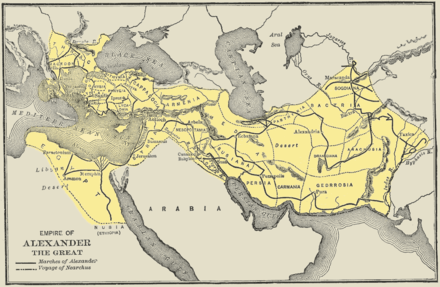
Alexander the Great
Long and sustained efforts to overthrow Persian rule proved unsuccessful and Cyprus remained a vassal of the Persian Empire until the Persian's defeat by Alexander the Great. Alexander the Great (Alexander of Macedon and Alexander III of Macedon), was born in Pella in 356 BC and died in Babylon in 323 BCE. Son of King Philip II and Olympias, he succeeded his father to the throne of Macedonia in 336 BC at the age of 20. He was perhaps the greatest commander in history and led his army in a series of victorious battles, creating a vast empire that stretched from Greece to Egypt in Africa and to the Caspian Sea and India. The various kingdoms of Cyprus became allies of Alexander following his victorious campaigns at Granicus (334 BC), Issus (333 BCE) and on the coast of Asia Minor, Syria and Phoenicia, where Persian naval bases were situated.
The Cypriot kings, learning of the victory of Alexander at Issus, and knowing that sooner or later, Alexander would be the new ruler of the island, since the occupation of Cyprus was necessary (along with that of Phoenicia) to open lines of communication to Egypt and Asia, rose up against their Persian overlords and made available to the fleet of Alexander the ships formerly in the service of Persia. There was a mutuality of interests: Alexander the Great increased the capacity of his fleet, and the Cypriot kings achieved political independence.
Siege of Tyre
From the area of Phoenicia, only Tyre resisted Alexander's control, and so he undertook a siege. The Cypriot fleet, together with Cypriot engineers, contributed much to the capture of this highly fortified city. Indeed, king Pnytagoras of Salamis, Androcles of Amathus, and Pasikratis of Soloi, took a personal part in the siege of Tyre.
Tyre, then the most important Phoenician city, was built on a small island that was 700 metres from the shore and had two harbors, the Egyptian to the south and Sidonian to the north. The Cypriot kings, in command of 120 ships, each with a very experienced crew, provided substantial assistance to Alexander in the siege of this city, which lasted for seven months. During the final attack, the Cypriots managed to occupy the Sidonian harbour and the northern part of Tyre, while the Phoenicians loyal to Alexander occupied the Egyptian harbour. Alexander also attacked the city with siege engines by constructing a "mole", a strip of soil from the coast opposite Tyre, to the island where the city was built. In this operation, Alexander was helped by many Cypriot and Phoenician engineers who built earthworks on his behalf. Many siege engines battered the city from the "mole" and from "ippagoga" ships.
Although they lost many quinqueremes, the Cypriots managed to help capture the city for Alexander. His gratitude was shown, for example, by the help he gave to Pnytagora, who seems to have been the main driver of this initiative to support Alexander, to incorporate the territory of the Cypriot kingdom of Tamassos into that of Salamis. The kingdom of Tamassos was then ruled by King Poumiaton of Kition who had purchased it for 50 talents from king Pasikypro.
In 331 BCE, while Alexander was returning from Egypt, he stayed for a while in Tyre, where the Cypriot kings, wishing to reaffirm their trust and support for him, put on a great show of honour.
Alexander in Asia
Cyprus was an experienced seafaring nation and Alexander used the Cypriot fleet during his campaign into India; because the country had many navigable rivers, he included a significant number of shipbuilders and rowers from Cyprus, Egypt, Phoenicia and Caria in his military expedition. Cypriot forces were led by Cypriot princes such as Nikoklis, son of King Pasikrati of Solon, and Nifothona, son of King Pnytagora of Salamis. As Alexander took over control of the administrative region that had been the Persian Empire, he promoted Cypriots to high office and great responsibility; in particular, Stasanor of Solon was appointed satrap of the Supreme Court and Drangon in 329 BC. The hope of full independence for Cyprus following the fall of the Persian Empire, however, was slow to be realized. The mints of Salamis, Kition and Paphos began to stamp coins on Alexander's behalf rather than in the name of the local kings.
The policy of Alexander the Great on Cyprus and its kings soon became clear: to free them from Persian rule but to put them under his own authority. Away from the coast of Cyprus, the interior kingdoms were left largely independent and the kings maintained their autonomy, although not in issues such as mining rights. Alexander sought to make clear that he considered himself the master of the island, and abolished the currencies of the Cypriot kingdoms, replacing them by the minting of his own coins.
Death of Alexander
The death of Alexander the Great in 323 BC, while still in his early thirties, put an end to Greek aspirations for global domination. The empire he had created was divided between his generals and successors, who immediately started fighting one another. The death of Alexander the Great marks the beginning of the Hellenistic period of Cypriot history. After the death of Alexander the Great, Cyprus passed on to the Ptolemaic rule. Still under Greek influence, Cyprus gained full access to the Greek culture and thus became fully hellenised.[12]
Egypt and Syria
The wars of Alexander's successors inevitably began to involve Cyprus, and focused on two claimants, Antigonus Monophthalmus in Syria (assisted by his son Demetrius Poliorcetes) and Ptolemy Lagus in Egypt.
The Cypriot kings who, so far, had managed largely to maintain their kingdoms' independence, found themselves in a new and difficult position. This was because, as Cyprus became the focus of discord between Ptolemy and Antigonus, the kings of the island now had to make new choices and alliances. Some Cypriot kingdoms chose alliance with Ptolemy, others sided with the Antigonus, yet others tried to remain neutral, leading to inevitable controversy and confrontation. The largest city and kingdom of Cyprus then appears to have been Salamis, whose king was Nicocreon. Nicocreon strongly supported Ptolemy. According to Arrian, he had the support of Pasikratis of Solon, Nikoklis of Paphos and Androcles of Amathus. Other kings of Cyprus, however, including Praxippos of Lapithos and Kyrenia, the Poumiaton (Pygmalion) of Kition and Stasioikos of Marion, allied themselves with Antigonus.
Against these, Nicocreon and other pro-Ptolemaic kings conducted military operations. Ptolemy sent military support to his allies, providing troops under the command of Seleucus and Menelaus. Lapithos-Kyrenia was occupied after a siege and Marion capitulated. Diodorus Siculus tells us that Amathus was forced to provide hostages, while Kition was laid siege to in about 315 BCE.
Ptolemy to Cyprus
Ptolemy entered Cyprus with further military forces in 312 BCE, captured and killed the king of Kition and arrested the pro-Antigonid kings of Marion and Lapithos-Kyrenia. He destroyed the city of Marion and annulled most of the former kingdoms of Cyprus. This crucial and decisive intervention by Ptolemy in 312 BCE gave more power to the kings of Solon and Paphos, and particularly to Nicocreon of Salamis, whom Ptolemy seems to have appreciated and trusted completelyand who won the cities and the wealth of expelled kings. Salamis extended its authority throughout eastern, central and northern Cyprus, since Kition and Lapithos were absorbed into it and Tamassos already belonged. Furthermore, Nicocreon of Salamis took office as chief general in Cyprus with the blessing of Ptolemy, effectively making him master of the whole island.
But the situation was fluid and the rulers of Solon and Paphos had been kept in power. Soon, King Nikoklis of Paphos was considered suspect; he was besieged and forced to suicide, and his entire family put to death (312 BCE). The following year (311 BCE) Nicocreon of Salamis died.
Demetrius
After the intervention of Ptolemy in Cyprus, which subjugated the island, Antigonus and his son Demetrius reacted against the besiegers and Demetrius led a large military operation in Cyprus.
Demetrius was born in 336 BC and initially fought under the command of his father in 317 BCE against Eumenes, where he particularly distinguished himself. In 307 BC he liberated Athens, restoring democracy there and in 306 BCE, led the war against the Ptolemies. Wishing to use Cyprus as a base for attacks against Western Asia, he sailed from Cilicia to Cyprus with a large infantry force, cavalry and naval ships. Meeting no resistance, he landed in the Karpasia peninsula and occupied the cities Urania and Karpasia. Meanwhile, Menelaus, brother of Ptolemy I Soter, the new general of the island, gathered his forces at Salamis. Ptolemy arrived to aid his brother, but was decisively defeated at the Battle of Salamis, after which Cyprus came under Antigonid control.
Demetrius's father Antigonus Monophthalmus was killed in the Battle of Ipsus in 301 BC and Demetrius, having reorganized the army, was proclaimed King of Macedon, but was evicted by Lysimachus and Pyrrhus. Cyprus came once again under Ptolemaic control in 294 BC and remained under Ptolemaic rule until 58 BC, when it became a Roman province. It was ruled by a series of governors sent from Egypt and sometimes formed a minor Ptolemaic kingdom during the power struggles of the 2nd and 1st centuries BC. During this time, Cyprus forged strong commercial relationships with Athens and Alexandria, two of the most important commercial centres of antiquity.
Full Hellenisation of Cyprus took place under Ptolemaic rule. During this period, Phoenician and native Cypriot traits disappeared, together with the old Cypriot syllabic script. A number of cities were founded during this time. For example, Arsinoe was founded between old and new Paphos by Ptolemy II. Ptolemaic rule was rigid and exploited the island's resources to the utmost, particularly timber and copper.
A great contemporary figure of Cypriot letters was the philosopher Zeno of Citium who was born at Kition about 336 BCE and founded the famous Stoic School of Philosophy at Athens, where he died about 263 BCE.
Roman period
Cyprus became a Roman province in 58 BCE. This came about, according to Strabo, because Publius Clodius Pulcher held a grudge against Ptolemy of Cyprus. The renowned Stoic and strict constitutionalist Cato the Younger was sent to annex Cyprus and organize it under Roman law. Cato was relentless in protecting Cyprus against the rapacious tax farmers that normally plagued the provinces of the Republican period. After the civil wars that ended the Roman Republic, Mark Antony gave the island to Cleopatra VII of Egypt and their daughter Cleopatra Selene, but it became a Roman province again after his defeat at the Battle of Actium in 31 BCE. From 22 BCE onwards, Cyprus was a senatorial province "divided into four districts centred around Paphus, Salamis, Amathus and Lapethus."[13] After the reforms of Diocletian it was placed under the Diocese of Oriens.
The Pax Romana (Roman peace) was only twice disturbed in Cyprus in three centuries of Roman occupation. The first serious interruption occurred in 115–16, when a revolt by Jews inspired by Messianic hopes broke out. Their leader was Artemion, a Jew with a Hellenised name, as was the practice of the time. The island suffered great losses in this war; it is believed that 240,000 Greek and Roman civilians were killed. Although this number may be exaggerated, there were few or no Roman troops stationed on the island to suppress the insurrection as the rebels wreaked havoc. After forces were sent to Cyprus and the uprising was put down, a law was passed that no Jews were permitted to land on Cyprian soil, even in cases of shipwreck.
Turmoil sprang up two centuries later in 333–4, when a local official Calocaerus revolted against Constantine I. This rebellion ended with the arrival of troops led by Flavius Dalmatius and the death of Calocaerus.[14]
Olive oil trade in the late Roman period
Olive oil was a very important part of daily life in the Mediterranean in the Roman Period. It was used for food, as a fuel for lamps, and as a basic ingredient in things like medicinal ointment, bath oils, skin oils, soaps, perfumes and cosmetics.[15] Even before the Roman Period, Cyprus was known for its olive oil, as indicated by Strabo when he said that "in fertility Cyprus is not inferior to any one of the islands, for it produces both good wine and good oil".[16]
There is evidence for both a local trade of Cypriot oil and for a larger trading network that may have reached as far as the Aegean, although most Cypriot oil was probably limited to the Eastern Mediterranean. Many olive oil presses have been found on Cyprus, and not just in rural areas, where they might be expected for personal, local use. They have been found in some of the larger coastal cities as well, including Paphos, Curium and Amathus. In Alexandria, Egypt, there is a large presence of a type of amphora made in Cyprus known as Late Roman 1 or LR1 that was used to carry oil. This indicates that a lot of Cypriot oil was being imported into Egypt. There is also evidence for Cypriot trade with Cilicia and Syria.[16]
Olive oil was also traded locally, around the island. Amphorae found at Alaminos-Latourou Chiftlik and Dreamer's Bay, indicate that the oil produced in these areas was mostly used locally or shipped to nearby towns.[17] The amphora found on a contemporary shipwreck at Cape Zevgari indicate that the vessel, a typical small merchant ship, was carrying oil and there is evidence from the location of the wreck and the ship itself that it was traveling only a short distance, probably west around the island.[18]
Christianity
Roman Cyprus was visited by the Apostles Paul, Barnabas and St. Mark, who came to the island at the beginning of their first missionary journey in 45 AD, according to Christian tradition, converting the people of Cyprus to Christianity and founding the Church of Cyprus, After their arrival in Salamis, they proceeded to Paphos where they converted the Roman governor Sergius Paulus to Christ. In the New Testament book of Acts of the Apostles, author St. Luke describes how a Jewish magician named Bar-Jesus (Elymas) was obstructing the Apostles in their preaching of the Gospel. Paul rebuked him, announcing that he would temporarily become blind due to God's judgment. Paul's prediction immediately came true. As a result of this, Sergius Paulus became a believer, being astonished at the teaching of the Lord. In this way, Cyprus became the first country in the world to be governed by a Christian ruler.
Paul is credited with underpinning claims for ecclesiastical independence from Antioch. At least three Cypriot bishops (the sees of Salamis, Tremithus, and Paphos) took part in the First Council of Nicaea in 325, and twelve Cypriot bishops were present at the Council of Sardica in 344. Early Cypriot Saints include: St. Heracleidius, St. Spiridon, St. Hilarion and St. Epiphanius.
Several earthquakes led to the destruction of Salamis at the beginning of the 4th century, at the same time drought and famine hit the island.
In 431 AD, the Church of Cyprus achieved its independence from the Patriarch of Antioch at the First Council of Ephesus. Emperor Zeno granted the archbishop of Cyprus the right to carry a sceptre instead of a pastoral staff.
Notes
- http://www.britishmuseum.org/research/collection_online/collection_object_details.aspx?objectId=291290&partId=1
- Yon, M., Malbran-Labat, F. 1995: "La stèle de Sargon II à Chypre", in A. Caubet (ed.), Khorsabad, le palais de Sargon II, roi d’Assyrie, Paris, 159–179.
- Tadmor, Hayim (2011). The royal inscriptions of Tiglath-pileser III (744–727 BC) and Shalmaneser V (726–722 BC), kings of Assyria / Hayim Tadmor and Shigeo Yamada ; with the editorial assistance of Jamie Novotny. Winona Lake, Ind.: Eisenbrauns. ISBN 9781575062204.
- Gjersad, Einar (1979). The Phoenician Colonization and Expansion in Cyprus.
- Viola, Frank (2004). The untold story of the New Testament church : an extraordinary guide to understanding the New Testament. Shippensburg, Pa.: Destiny Image. ISBN 0-7684-2236-1.
- Christou, Demos, 1986. Kourion: A Complete Guide to Its Monuments and Local Museum. Filokipros Publishing Co. Ltd., Nicosia. Introduction, p 7.
- Na'aman, N., 'Sargon II and the rebellion of the Cypriote kings against Shilta of Tyre', Orientalia 67 (1998), 239–247 [reprinted in N. Na'aman, Ancient Israel and its neighbors: interaction and counteraction (Collected essays, vol. 1), Winona Lake: Eisenbrauns, 2005, 118–128].
- Radner, K. 2010: "The Stele of Sargon II of Assyria at Kition: A focus for an emerging Cypriot identity?”, in R. Rollinger, B. Gufler, M. Lang, I. Madreiter (eds), Interkulturalität in der Alten Welt: Vorderasien, Hellas, Ägypten und die vielfältigen Ebenen des Kontakts, Wiesbaden, 429–449.
- "The Cypriot rulers as client kings of the Assyrian empire". The many kingdoms of Cyprus. 5 November 2012. Retrieved 21 January 2016.
- Frazer, J G, 1922, reprinted 1996. The Golden Bough: A Study in Magic and Religion. Abridged edition, with an introduction by George W Stocking, Jr. XXXI, Adonis in Cyprus, pp 397–404. Penguin Books Limited.
- "Persian Wars Timeline". www.About.com. N.S. Gills. Retrieved 14 August 2014.
- Loizides, Antonios. "Cyprus". Cyprus – Ancient History.
- Talbert, Richard J A (Ed), 1985. Atlas of Classical History. Routledge. Roman Cyprus, pp 156–7.
- George Hill, (1940, reprint 2010) A History of Cyprus, vol. 1 (New York: Cambridge University Press), p. 244.
- Tyree, E.L. 1996, "The Olive Pit and Roman Oil Making". The Biblical Archaeologist 59: 171–8.
- Papacostas, T., 2001, The Economy of Late Antique Cyprus. In: Economy and Exchange in the East Mediterranean during Late Antiquity. Proceedings of a conference at Somerville College, Oxford, 29 May 1999, edited by S. Kingsley and M. Decker, 107–28. Oxford: Oxbow Books.
- Leonard, J. and S. Demesticha. 2004, Fundamental Links in the Economic Chain: Local Ports and International trade in Roman and Early Christian Cyprus. In: Transport Amphorae and Trade in the Eastern Mediterranean. Acts of the International Colloquium at the Danish Institute at Athens, September 26–9, 2002, edited by J. Eiring and J. Lund, 189–202. Aarhus: Aarhus University Press.
- Leidwanger, J. 2007, Two Late Roman Wrecks from Southern Cyprus. IJNA 36: 308–16.
Further reading
- Cobham, C D, 1908. Excerpta Cypria, materials for a history of Cyprus. Cambridge. Includes the Classical Sources.
- Hermary, Antoine; Mertens, Joan R. (2014). The Cesnola collection of Cypriot art: stone sculpture. New York: The Metropolitan Museum of Art. ISBN 9780300206715.
- Hunt, D, 1990. Footprints in Cyprus. London, Trigraph.
- Leidwanger, J, 2007, Two Late Roman Wrecks from Southern Cyprus. IJNA 36: pp 308–16.
- Leonard, J. and Demesticha, S, 2004. Fundamental Links in the Economic Chain: Local Ports and International trade in Roman and Early Christian Cyprus. In: Transport Amphorae and Trade in the Eastern Mediterranean, Acts of the International Colloquium at the Danish Institute at Athens, September 26–9, 2002, edited by J. Eiring and J. Lund, Aarhus, Aarhus University Press: pp 189–202.
- Papacostas, T, 2001, The Economy of Late Antique Cyprus. In: Economy and Exchange in the East Mediterranean during Late Antiquity. Proceedings of a conference at Somerville College, Oxford, 29 May 1999, edited by S. Kingsley and M. Decker, Oxford, Oxbow Books: pp 107–28.
- Şevketoğlu, M. 2015, ”Akanthou- Arkosykos, a ninth Millenium BC coastal settlement in Cyprus” in Environmental Archaeology, Association for Environmental Archaeology
- Tatton-Brown, Veronica, 1979. Cyprus BC, 7000 years of history. London, British Museum Publications.
- Tyree, E L, 1996.
- Winbladh, M.-L., Cypriote Antiquities in the Medelhavsmuseet, Stockholm 1977.
- Winbladh, M-L., 'Adventuring with Cyprus. A Chronicle of the Swedish Cyprus Expedition 1927 – 1931' in The Northern Face of Cyprus. New Studies in Cypriot Archaeology and Art History, eds. Hazar Kaba & Summerer, Latife, Istanbul 2016
- Winbladh, M.-L., Kıbrıs Macerası – The Cyprus Adventure – Περιπετεια στην Κυπρο (1927 - 1931), Galeri Kültür Kitabevi, Lefkoşa 2013
- Winbladh, M.-L., The Origins of The Cypriots. With Scientific Data of Archaeology and Genetics, Galeri Kultur Publishing, Lefkoşa 2020
- Voskos, I. & Knapp A.B. 2008, ”Cyprus at the End of the Late Bronze Age: Crisis and Colonization or Continuity and Hybridization?” American Journal of Archaeology 112
